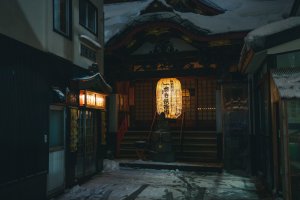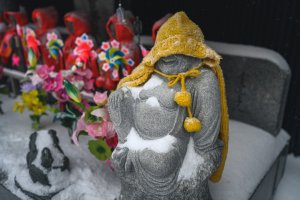Japan is a popular travel destination these days. It’s easy to see why – with locations like Tokyo and Kyoto, and a diverse food scene as exotic as the culture, Japan is the perfect place for anyone looking for adventure. Unfortunately, many visitors only travel to the hot spots, and thus miss out on the amazing experiences that can be found throughout the rest of the country. During a recent trip to Japan, I had the opportunity to break that trend and spend some time in Japan’s northernmost areas: Aomori and Hokkaido. These beautiful places offer some of the best scenery in the country, and boast of unique histories and cultures, making them the perfect destinations to experience a new side of Japan.
Day 1
My first day began in Aomori City, a port city which lies in the center of Aomori prefecture. One of the main things I wanted to explore during this trip was the Jomon Era history which Northern Japan is known for. So from Aomori City, I took the shuttle bus (Nebutan-go) to the Sannai-Maruyama Historical Site. The ride is only about 20-30 minutes, and especially during winter, it’s nice to let someone else do the driving! Although the large amount of snow blocked off parts of the ruins, there was still a lot to see as I learned about the ancient history of this area.

The Sannai-Maruyama Historical Site has an especially unique piece of architecture – a large wooden structure that’s several stories tall which towers over the landscape. The replica gives you an idea of the design prowess of the Jomon people millennia ago. If you get cold walking around outside, the indoor museum allows you to learn about the history of the Jomon people and provides an opportunity to create your own clay figurines like those on display in the museum. It’s a great experience on a cold snowy day!
After a morning at the museum, I took an English taxi back to Shin-Aomori Station, and hopped on the Hokkaido Shinkansen towards Hakodate. I have always loved riding on the Japanese shinkansen (bullet train). The shinkansen isn’t just a method of transportation – it’s a travel experience, and that is especially the case with the line which connects Aomori and Hokkaido. The ride from Shin-Aomori Station to Shin-Hakodate Hokuto Station covers 92.5 miles (148.8km), including a 33.5 mile (54 km) stretch under the Tsugaru Strait between Aomori Prefecture and Hokkaido. It’s amazing to think you are speeding along at over 100 mph while comfortably seated on a bullet train hundreds of feet below the ocean floor!

Upon arrival at Shin-Hakodate Hokuto Station, I took the short trip on the Hakodate Liner to Hakodate Station where I had lunch at Hakodate Asaichi (Morning Market). There are a number of different seafood restaurants here, offering delectable local specialties like ikura (fish roe), crab, and uni (sea urchin). I chose a rice bowl filled to the brim with fresh crab meat. Along with a bowl of miso soup and some other sides, it was a delicious way to warm up from the falling snow outside.

Sticking to the trip theme of Jomon history, my next stop was the Hakodate Jomon Culture Center. However, thanks to information from my multilingual taxi driver, I was also able to take a brief stop by a nearby monkey onsen (hot spring). Given the cold and snowy weather, I have to admit I was tempted to join them! However, history was waiting, so I continued on to the Jomon Center to learn more about the Jomon period and people.

On display at the Hakodate Jomon Culture Center are a number of different artifacts from the Jomon period, including everything from arrowheads to handmade figurines. In fact, one of Japan’s most prized possessions is on display in the museum – the hollow dogu, a hollow humanoid clay figure which was found largely intact in the area. There are many guesses as to the purpose of this clay figure, but with so little information surviving from the era, exact details are difficult to come by. Nevertheless, looking at such a well-preserved item from thousands of years ago is an incredible experience for any history lover.
Following an engaging and educational stop at the museum, I took the taxi back to Hakodate for the evening. I had originally intended to visit Mt. Hakodate to enjoy the view over the city, but high winds and snowy conditions shut down the ropeway. A telltale sign of a great travel destination is the area’s ability to handle changes in plans, and Hakodate was able to do exactly that! An impromptu stop by the Goryokaku Tower offered splendid views over the city and kept me nice and warm as well. After visiting the tower, the taxi guide took me to several spots on nearby hills overlooking the city. Considering I wasn’t able to go up Mt. Hakodate, I was impressed with the many stunning views I was able to enjoy!
Day 2
After a wonderful stay at the classy La Vista Hakodate Bay, I began my second day, starting with further exploration in the Hakodate area. Although it had snowed constantly since I first arrived in Northern Japan, this morning was sunny and beautiful, so I decided to head to Goryokaku Tower again to check out the city views in the daylight. Hakodate is famous for its street cars, so I hitched a ride on one headed in that direction. In addition to being inexpensive, the street car provides views of the city and an experience of daily life in Hakodate. Is there a better way to travel? I think not!

The view from Goryokaku Tower this morning was fantastic. Everything from the city to the mountains in the distance were covered in snow, making for a magical morning scene. The view of Goryokaku Park was especially grand, though I couldn’t help but dream of seeing it in the spring, when the park is surrounded in Japan’s famous cherry blossom trees.
I could have easily explored the Hakodate area for days, but my scheduled time was coming to a close, so it was time to head back towards Aomori. Before leaving Hokkaido however, I had a few more things to experience. First was the South Hokkaido Railway, which takes travelers along the Hakodate Bay coast to Kikonai Station. The ride itself is beautiful, with expansive views of both the coast and the surrounding mountains. Arriving in Kikonai, the town struck me as one those easily overlooked places with a lot to experience, especially if you’re interested in local life. A brief stop by Misogi No Sato, a rest area adjacent to the station, provides much information about the town and its culture, along with some delicious restaurants. If you’re in the mood for pasta, make sure to check out Donande’s. I’m honestly not a huge pasta fan, but this was some of the freshest, tastiest pasta I’ve eaten!
After lunch, I got back on the shinkansen, said goodbye to Hokkaido and traveled back to Aomori Prefecture. From Okutsugaru-Imabetsu station, I hopped on the bus towards the Tsugaru Railway. The Tsugaru Railway takes travelers on a one-man car through the Aomori countryside, via some of the best scenaries in the area. For example, Ashinokoen is one of the most beautiful spots for cherry blossoms in the spring. On this day however, my destination was Tsugaru Goshogawara Station to visit the Tachineputa Museum.
Tachineputa are one of the many unique parts of life in Aomori. Each summer, these massive multi-story festival floats leave their home in the museum and make their way down the nearby streets. Each float is handcrafted by artists and volunteer workers, who painstakingly work on them throughout the year. The museum provides visitors with close-up views of the floats, as well as information about how the floats are created, and even out-of-season experiences connected with the yearly festival. If you can’t make it to the area for the festival in the summer, stopping by the museum is the next best thing.

Once I was finished exploring the museum, I boarded the konan bus towards Aomori City. You might notice that in all of these travels I’ve been using public transportation. That’s one of the great things about Japan – public transportation is widely available, and much less expensive than renting a car and paying for gas and tolls. Especially during the brutal winter weather Northern Japan is known for, it’s nice to leave the navigation to experienced and professional drivers.
Upon arriving in Aomori City, I was able to see one of the events I was most excited about – the winter lantern festival in front of the Nebuta Museum Warasse. Hundreds of snow lanterns were set up between the nebuta museum and A-Factory (both worthy destinations themselves), creating a splendid winter illumination display. In addition to the snow lanterns, a variety of handmade paper lanterns were set up, all created by local school children. There was even an igloo made by the college students from Aomori City! The festival is simple, yet it’s one of those unique things that you’ll find only in a place like Aomori.

Following a quick stop at the A-Factory to warm up, I took the Aomori Railway to Asamushi Onsen Station, where I was picked up by the staff from the Asamushi Sakura Kanko Hotel. This hotel is a lot more like a Japanese inn, boasting Japanese-style rooms with stunning views over Aomori Bay, as well as an onsen and delicious Japanese cuisine. I was even able to enjoy a brief shamisen show at the hotel. Shamisen is a unique Japanese stringed instrument, and something Aomori is famous for. The talented players made it easy to relax after a long day of travel, although the hot spring bath helped with that as well!
Day 3
After a good night’s rest and a scrumptious breakfast, my final day began with a trip to Hachinohe on Aomori’s eastern coast. My first stop in the Hachinohe area was the Korekawa Archaeological Institution, to learn more about the history of the Jomon people. Out of all the Jomon history museums I visited, this one was probably my favorite. The displays were fascinating, the English guide capably explained the history to me, and there were even interactive crafts to do after I finished viewing the museum exhibits. If you have kids, you likely know how helpful these kinds of crafts are for helping children learn. It’s a great way for them to remember the experience!
As I waited for the bus to take me back to downtown Hachinohe, I enjoyed a curry lunch made by hand by a wonderful older woman who worked at the museum cafeteria. This curry meal included several foods which the Jomon people would have eaten, such as crushed nuts, carrots, and eggs. Of course, I doubt that curry was on the Jomon menu, but it was a fun twist on a common food in Japan!
Back in Hachinohe, I only had a few hours before it was time to head back to Tokyo, but that left plenty of time to explore a bit of the downtown area. If you’ve got some time to kill, the Hachinohe Portal Museum “hacchi” is the perfect place to explore. Although it’s called a museum, “hacchi” is really an expansive community center with something for everybody. In one building, you’ll find everything from information about area festivals to a play area for children to small shops selling local crafts. I was even able to learn how to make a certain kind of specialty cloth called Nanbu-Sakiori which is famous in the area.

After visiting “hacchi”, I paid a visit to the nearby Hachinohe Book Center. Of course, you’ll need to be able to read Japanese to enjoy the experience fully, but the book shop allows visitors to sit down and read the book casually as if it was a library, so you can take your time to decide if you want to purchase something. Following that, I then took a stroll down Hachinohe’s famous Yatai Mura food stall street. The food stalls are most active in the evening and I was quickly running out of time before my train left, so I didn’t visit any of the food stalls themselves, but walking down the narrow path made me wish I could have! As it is often said, all good things must come to an end, and so I sadly left Hachinohe to travel back to Tokyo. Thankfully, a long shinkansen ride was waiting for me, giving me time to reflect on the past several days exploring Aomori and Hokkaido.
As a foreigner, I have always loved Japan, but Aomori and Hokkaido have taken that love to another level. Between the unique culture and food, and the awe inspiring history and scenery, this is a place that any visitor would love. Especially as a photographer, getting to see all of this with my camera is a dream come true. In fact, I love the area so much, I’m hoping to put together a photography tour for the area in the near future (so stay tuned)! Of course, it’s great to see places like Tokyo and Kyoto, but to me, destinations like Aomori and Hakodate are real Japan. This is where real Japanese life and culture thrive. This is where the beauty of Japan shines. And thanks to the Jomon people long ago, this is where Japan truly began.
































